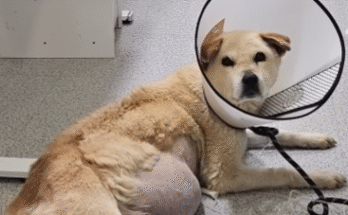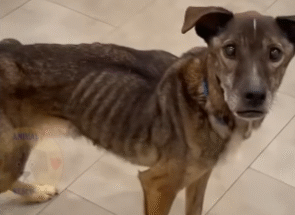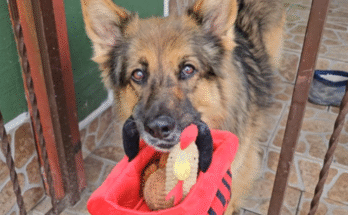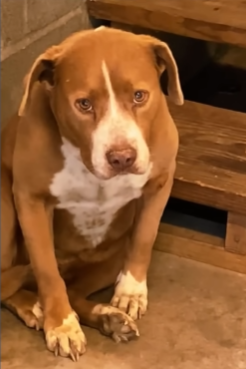
The sun had just begun its slow climb over the horizon, casting a warm, golden glow across the desolate yard. But the light could not reach the shadow that had lingered there for fifteen long years. Fifteen years of neglect, of solitude, of being forgotten by the world that had promised care and love but delivered only chains and emptiness. And there she was — a dog whose life had been reduced to a rusty chain, a small patch of dirt, and a lingering sadness that seemed almost tangible in the air.
Her name, I would soon learn, was Daisy. But at that moment, she had no name, no recognition, no human touch that wasn’t accompanied by fear or indifference. She was a medium-sized dog with fur dulled by dust and age, eyes sunken yet still holding traces of intelligence and longing. Her body was thin, the bones of her hips and ribs visible beneath her patchy coat. The chain that held her was old and heavy, meant to restrain movement but unable to restrain the passage of time. Fifteen years of it had left its mark — on her muscles, on her spirit, and on her trust in the world.
When I first approached, Daisy didn’t react with anger or fear as one might expect. Instead, she froze. Her ears twitched, her head lowered slightly, and her eyes met mine with a mixture of curiosity and caution that was heartbreaking. Fifteen years of being ignored, chained, and forgotten had taught her to wait, to not expect kindness, to survive quietly.
I knelt a few feet away, lowering myself to her level. “Hello, Daisy,” I said softly, the name feeling right even though I had just made it up. “It’s okay… I won’t hurt you.”
She blinked slowly, then took a tiny, tentative step toward me, her paws careful and measured as if each movement carried the weight of years of hesitation. I could see it in her eyes — the hope that dared not rise too high for fear of disappointment, the longing for connection that had been starved for decades.
The chain rattled faintly as she moved, a sound that had become the soundtrack of her life. For fifteen years, it had been her world: the length of the chain, the yard it allowed, and the humans who passed by without a second thought. Now, that chain was no longer just a physical restraint — it was a symbol of every lonely birthday, every empty meal, every moment of longing for love that had gone unanswered.
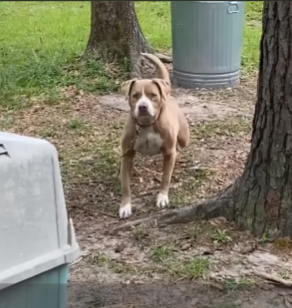
I extended a hand slowly, letting her sniff me first. Her nose, wet and cool, pressed against my fingers, and I could feel the shiver that ran through her tiny, frail body. She trembled, not with aggression, but with the weight of years of fear and longing. I whispered again, “It’s okay… you’re safe now.”
Then it happened. Her reaction — the way she lowered herself into a small, hesitant bow, tail tucked, yet her eyes shining with tears that I could almost feel. She pressed her forehead gently against the back of my hand, trembling violently, and for the first time in fifteen years, allowed herself to seek comfort. My heart broke into a thousand pieces right then and there. This dog, who had survived so long in silence and solitude, was finally showing me that she still had love to give, that she still remembered what it was to trust.
I could see the muscles in her body begin to relax slowly. The trembles continued, but now they were mixed with relief, with cautious hope. Fifteen years of being unseen, fifteen years of being ignored, and now — a single human, kneeling on the dirt, offering kindness, and she responded with everything she had. Her reaction spoke volumes: I’ve waited my whole life for this. Please… don’t go.
Carefully, I unhooked the chain from the stake in the ground. Daisy flinched at the sudden freedom, her legs wobbling beneath her. She had not walked without restraint in over a decade, perhaps never. Her paws touched the ground tentatively, then slowly she began to move, circling me, sniffing my shoes, and finally, inching closer. Her eyes were wide, reflecting both the disbelief and joy of newfound freedom.
I brought a bowl of water and some food, setting it down a few feet away. She approached cautiously, ears flicking back, yet the hunger in her gaze was undeniable. Each bite she took seemed to strengthen her tiny body, and with every sip, I could see a little more life returning to her. The chain had not only restricted her movement — it had limited her world, and now, finally, she was able to stretch herself into something closer to the creature she was always meant to be.
Over the next few days, Daisy’s transformation was astonishing. The bones that had been so visible began to fill out, her coat slowly regaining some of its former luster, and her eyes, once dull with despair, now held a spark of mischief and curiosity. Yet, the emotional scars remained. She flinched at sudden movements, jumped at loud noises, and occasionally barked at shadows that reminded her of a lifetime of fear.

Even with these scars, she began to trust me more each day. She would rest her head against my leg, follow me around the yard, and sometimes, in a burst of uncontained joy, run circles around the garden, her legs stiff but gaining strength. Watching her, I realized the true depth of what it means to be chained and forgotten — it is not just the physical restraint, but the slow erosion of spirit. And Daisy, even after fifteen years, had preserved a part of her soul that refused to break.
Her first real walk outside the yard was magical. At first, she hesitated at the gate, glancing back as if to make sure the world would not abandon her again. Then, with a tiny bark of determination, she stepped forward. Her legs moved awkwardly, stiff from years of immobility, yet each step was triumphant. I could see her begin to understand that there was a world beyond the chain, a world that she could explore, a life she could finally live.
At night, Daisy would curl up in her new bed, soft blankets replacing the cold, hard ground she had endured for so long. Sometimes she would whine softly in her sleep, a reminder of the pain she had endured, and I would sit beside her, stroking her fur, whispering promises that she was safe now, that she would never be forgotten again.
Her reaction that first day, pressing her trembling body against my hand, will stay with me forever. It was the purest expression of longing, relief, and gratitude — a mixture of heartbreak and hope that words could scarcely capture. For fifteen years, she had been invisible, ignored, and restrained, and yet, in that moment, she trusted again. Her faith in life had been battered, but not destroyed.

Now, every day is a celebration for Daisy. She greets the morning with a wagging tail, she barks at squirrels and birds, and she cuddles with a joy that seems almost unreal for a dog who had spent half her life forgotten. The world is new to her, but she approaches it with the cautious courage of a survivor and the exuberance of one who has been given a second chance.
Her story is a powerful reminder: animals, like humans, feel deeply, remember every moment of neglect, and yet, given kindness and care, they can flourish. Daisy’s fifteen years on a chain could have destroyed her, but her reaction when I approached that first time proved the resilience of the heart, the longing for connection, and the capacity for trust even after unimaginable suffering.
Chained and forgotten for fifteen years, her life could have been one of bitterness and despair. Instead, it became a testament to survival, hope, and the transformative power of compassion. The day I knelt before her, and she trembled and pressed against my hand, was the day her story changed forever. And in her eyes, I saw the unspoken plea that every neglected creature carries: Please… don’t forget me again.
And I promised her, silently and aloud, that never again would she be chained, ignored, or forgotten.
